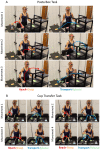Characterization of normative hand movements during two functional upper limb tasks
- PMID: 29928022
- PMCID: PMC6013217
- DOI: 10.1371/journal.pone.0199549
Characterization of normative hand movements during two functional upper limb tasks
Abstract
Background: Dexterous hand function is crucial for completing activities of daily living (ADLs), which typically require precise hand-object interactions. Kinematic analyses of hand trajectory, hand velocity, and grip aperture provide valuable mechanistic insights into task performance, but there is a need for standardized tasks representative of ADLs that are amenable to motion capture and show consistent performance in non-disabled individuals. Our objective was to develop two standardized functional upper limb tasks and to quantitatively characterize the kinematics of normative hand movement.
Methods: Twenty non-disabled participants were recruited to perform two tasks: the Pasta Box Task and Cup Transfer Task. A 12-camera motion capture system was used to collect kinematic data from which hand movement and grip aperture measures were calculated. Measures reported for reach-grasp and transport-release segments were hand distance travelled, hand trajectory variability, movement time, peak and percent-to-peak hand velocity, number of movement units, peak and percent-to-peak grip aperture, and percent-to-peak hand deceleration. A between-session repeatability analysis was conducted on 10 participants.
Results: Movement times were longer for transport-release compared to reach-grasp for every movement. Hand and grip aperture measures had low variability, with 55 out of 63 measures showing good repeatability (ICC > 0.75). Cross-body movements in the Pasta Box Task had longer movement times and reduced percent-to-peak hand velocity values. The Cup Transfer Task showed decoupling of peak grip aperture and peak hand deceleration for all movements. Movements requiring the clearing of an obstacle while transporting an object displayed a double velocity peak and typically a longer deceleration phase.
Discussion: Normative hand kinematics for two standardized functional tasks challenging various aspects of hand-object interactions important for ADLs showed excellent repeatability. The consistency in normative task performance across a variety of task demands shows promise as a potential outcome assessment for populations with upper limb impairment.
Conflict of interest statement
The authors have declared that no competing interests exist.
Figures





References
-
- Lang CE, Wagner JM, Bastian AJ, Hu Q, Edwards DF, Sahrmann SA, et al. Deficits in grasp versus reach during acute hemiparesis. Exp Brain Res. 2005;166(1):126–36. doi: 10.1007/s00221-005-2350-6 - DOI - PubMed
-
- Metzger AJ, Dromerick AW, Holley RJ, Lum PS. Characterization of compensatory trunk movements during prosthetic upper limb reaching tasks. Arch Phys Med Rehabil. 2012;93(11):2029–34. doi: 10.1016/j.apmr.2012.03.011 - DOI - PubMed
-
- Hebert JS, Lewicke J. Case report of modified Box and Blocks test with motion capture to measure prosthetic function. J Rehabil Res Dev. 2012;49(8):1163–74. - PubMed
-
- De Los Reyes-Guzmán A, Dimbwadyo-Terrer I, Trincado-Alonso F, Monasterio-Huelin F, Torricelli D, Gil-Agudo A. Quantitative assessment based on kinematic measures of functional impairments during upper extremity movements: a review. Clin Biomech. 2014;29(7):719–27. - PubMed
Publication types
MeSH terms
LinkOut - more resources
Full Text Sources
Other Literature Sources

